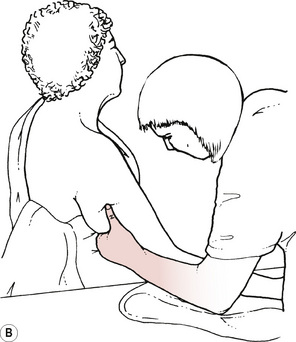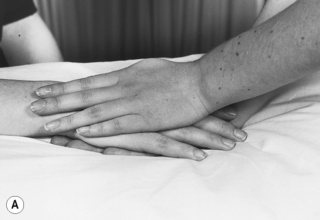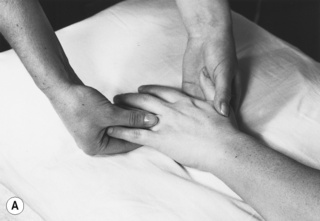8 Regional application of classical massage techniques
The basic massage strokes must be adapted to the contours of the body and guided by the underlying anatomy (Fig. 8.1). In this chapter, we suggest a format for each region.
Upper limb: the arm
Manipulations
Effleurage: apply three overlapping strokes to the flexor aspect of the forearm with your right hand, repeat on the extensor aspect with your left hand (Fig. 8.2).
Kneading: trapezius, two-handed reciprocal kneading to deltoid (Fig. 8.3), biceps, triceps, forearm and hand.
Finger kneading: fibres of deltoid, between the forearm muscles, tendons of the wrist.
Picking up: deltoid, biceps, triceps (Fig. 8.4), brachioradialis.
Wringing: triceps (Fig. 8.5), biceps, brachioradialis.
Muscle shaking: biceps, triceps, brachioradialis (Fig. 8.6).
Clapping: flexor and extensor aspects of the arm and forearm (see Fig. 7.11).
Hacking: flexor and extensor aspects of the arm (Fig. 8.7) and forearm.
Upper limb: the hand
Special anatomical points
Swelling is commonly trapped in the fibrous compartments of the hand.
The areas between adjacent metacarpal bones may need special attention.
Splintage or chronic swelling may lead to soft tissue contracture which will require petrissage manipulations.
The hand contains numerous muscles and tendons that can be implicated in burns and scarring. As resulting disability can be serious massage should be vigorous.
It is often desirable to include the wrist in a hand massage (see Fig. 8.11); manipulations may include thumb kneading to the carpal bones, petrissage to the flexor retinaculum.
Manipulations
Effleurage: to the nearest proximal lymph glands with the whole hand (Fig. 8.8), individual fingers (Fig. 8.9), between the metacarpals, thenar and hypothenar eminences.
Kneading: finger kneading to individual fingers, thumb kneading to the thenar eminence and hypothenar eminence (Fig. 8.10), between the metacarpals. (See also Fig. 8.11.)
Wringing: skin on the dorsum of the hand (Fig. 8.12), the muscles of the thenar eminence (Fig. 8.13) and hypothenar eminence.
Picking up: the dorsum of the hand, the thenar and hypothenar eminences.


Figure 8.10 • (A, B) Thumb kneading the hypothenar eminence.
• The left hand of the therapist is supporting the patient’s hand.
Lower limb: the leg and foot
Special anatomical points
Lymph glands: in the popliteal fossa behind the knee and in the groin.
Knee, patella and iliotibial band require special attention.
Anatomical spaces behind the malleoli and either side of the Achilles tendon can contain swelling.
The posterior aspect of the limb can be massaged with the patient lying prone.
Major muscle groups: quadriceps, hamstrings, adductors, anterior tibials, triceps surae, interossei and the layers of the foot.






























